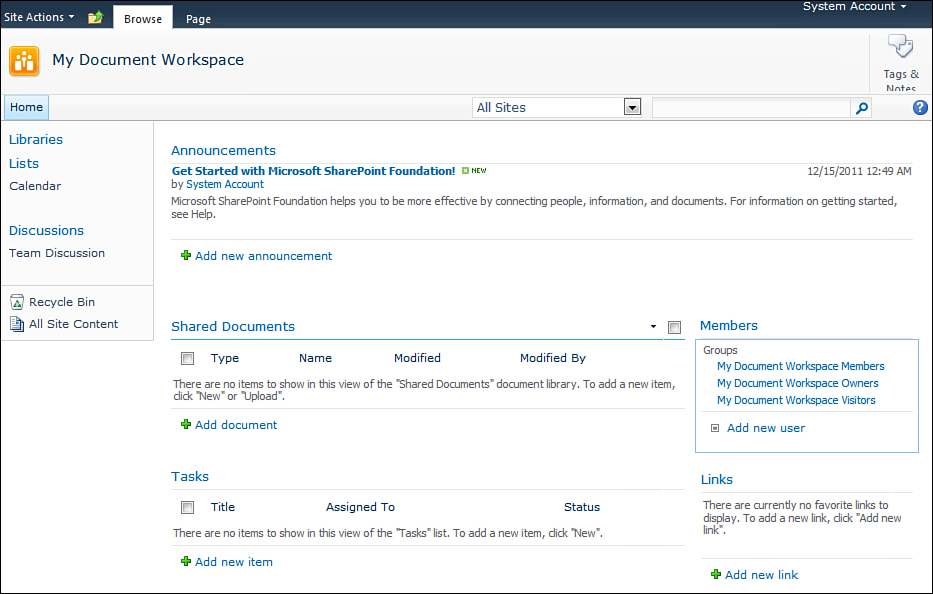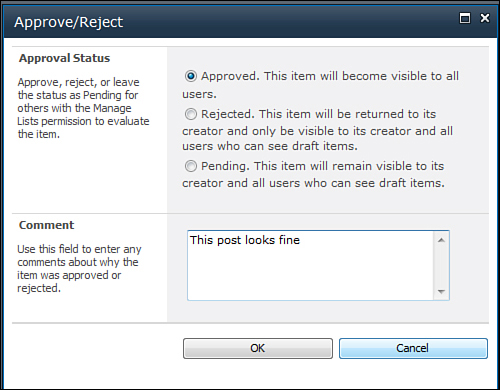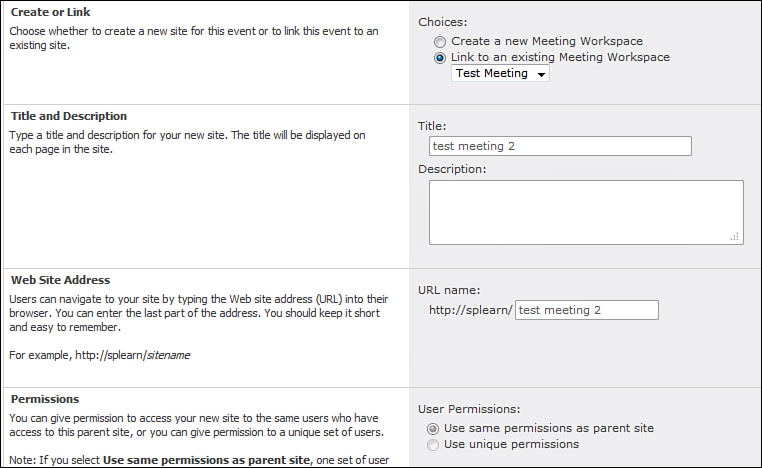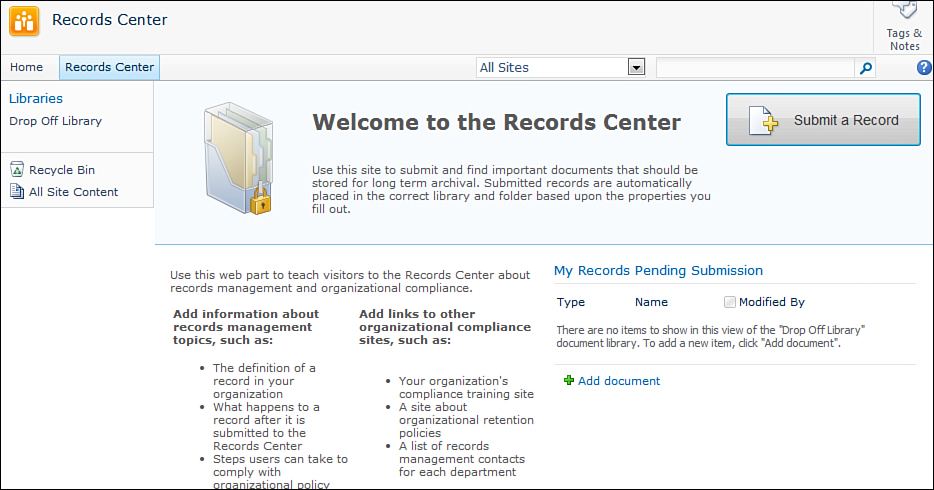Understanding and Working with Out of the Box Site Templates
You can create a variety of types of sites in SharePoint 2010 by selecting the various templates that come out of the box with SharePoint 2010. You might have already seen the various templates available when creating a site collection earlier. These templates are mainly classified under four categories: Collaboration, Meetings, Enterprise, and Publishing. This section looks at some commonly used site templates.
Team Site
The Team Site template is one of the most used templates in SharePoint. As the name suggests the site enables effective collaboration for a team. Like in a SharePoint 2007 team site, the SharePoint 2010 team site contains a Shared Documents library, Calendar list, Announcement list, Links list, Tasks list, and Team Discussion discussion board. In addition SharePoint 2010 offers new lists and libraries such as the Site Assets library for storing media files and the Site Pages library to store site pages. Figure 4.22 shows the home page of a team site.
Figure 4.22. Team site home page
In team sites everything is a wiki. You can edit the pages like a wiki page. Just click Edit and start typing or insert web parts on the page. This is shown in Figure 4.23.
Figure 4.23. Team site home page in Edit mode
Blank Site
The Blank Site template is the simplest template. It does not contain any lists or libraries except for the Style Library. You may use this template when you want to create your content on a totally blank site.
Document Workspace
A document workspace is a place for multiple members of your team to work together on a document. The document workspace provides a document library for storing the primary document and supporting files. It also contains a Tasks list for creating and tracking tasks, and a Links list for storing resources related to the document. In addition there are the Calendar and Announcements lists. Figure 4.24 shows the Document Workspace home page.
Figure 4.24. Document Workspace home page
Blog
Blogs are sites where users can write posts and other users can comment on them. They are part of the social networking features provided by SharePoint 2010.
The blog site contains the Posts lists to store posts, Categories list to store categories for blogs, and Comments list and Photos library. Figure 4.25 shows the home page of a blog site.
Figure 4.25. Blog site home page
To create a new post, click Create a Post under Blogs Tools on the right. You can assign multiple categories to the post. To create new categories click Add New Category on the left navigation of the blog home page. Figure 4.26 shows the screen to create a new blog post.
Figure 4.26. Creating a new blog post
Once you save the post you need to approve it for the post to be visible to everyone. Go to the Manage Posts link on the right under Blog Tools in the home page. Select the post you want to approve and click Approve/Reject from the ribbon (see Figure 4.27). Once the post is approved you can see it on the home page and also add comments to it.
Figure 4.27. Approving a new blog post
Group Work Site
The Group Work Site template is a new template in SharePoint 2010. Figure 4.28 shows the home page of the Group Work Site template.
Figure 4.28. The Group Work Site template
Like the Team Site template the Group Work Site template is also for enabling effective collaboration within a team, and like the Team Site template the Group Work Site template contains the Announcement list, discussion board, Tasks list, Links list, and Shared Documents library. In addition, the Group Work Site template contains the following lists:
• Circulations list—Allows circulating information among various team members and request and track confirmations
• Phone Call Memo list—Can be used to store follow-up information related to phone calls
• Whereabouts list—Enables you to store information about the locations of the team members
• Resources list—Can be used to store the information on various resources such as meeting rooms, projectors, and so on
In addition to the preceding lists, the Group Work Site replaces the Calendar list of the Team Site with a more advanced Group Calendar list. The Group Calendar list enables you to see the schedule of multiple team members as shown in Figure 4.29.
Figure 4.29. Group Work Calendar
In addition the Group Calendar list enables you to specify resources created in the Resources list and also allows checking for conflicts in booking the resources as shown in Figure 4.30.
Figure 4.30. Creating a new item in a Group Calendar list
Meeting Workspace Templates
Meeting workspaces enable you to track information related to meetings. They usually work in conjunction with a calendar. Go to a Calendar list in a team site and create a new calendar item in it. Select the Workspace check box and click Save (see Figure 4.31).
Figure 4.31. Creating a new event in Group Calendar
You are taken to a new screen that provides the option to create a new meeting workspace or to select an existing one. Click OK to proceed further (see Figure 4.32).
Figure 4.32. Creating a new meeting workspace
You now get the option to select a meeting workspace template. Select Basic Meeting Workspace and click OK. A new site of type Basic Meeting Workspace is created and linked to your event in the calendar. Add one more event and this time instead of creating a new meeting workspace select the one you just created and click OK (see Figure 4.33).
Figure 4.33. Linking to an existing meeting workspace
You should now see in the left a navigation mechanism to browse to show the different meeting dates. You can create the following different types of meeting workspaces.
Basic Meeting Workspace
The Basic Meeting Workspace contains the Objectives, Attendees, and Agenda lists. These lists form the basics required for managing the meetings.
Blank Meeting Workspace
The Blank Meeting Workspace template creates a blank site template that can be used as a meeting workspace. The Blank Meeting Workspace contains only the Attendees list by default.
Decision Meeting Workspace
The Decision Meeting Workspace template provides features for tracking decisions made during the meetings. It contains the Agenda list, Attendees list, Decisions list, Objectives list, and Tasks list. In addition it contains a document library named Document Library.
Social Meeting Workspace
The Social Meeting Workspace template allows tracking of social occasions. It contains the Attendees list, Things to Bring list, Directions list, a discussion board, and a Picture library. The Things To Bring list tracks information about items that each attendee needs to bring to the meetings. The Directions list enables you to track any custom text. In addition the Picture library enables you to share pictures, and the Discussion Board enables you to plan the social occasions making this template a Social Meeting Workspace.
Multipage Meeting Workspace
The Multipage Meeting Workspace template as the name suggests enables you to create multiple pages in the meeting workspace. It contains the Agenda list, Attendees list, and the Objectives list.
Document Center
The Document Center template is for effectively managing documents. Figure 4.34 shows the home page of a Document Center.
Figure 4.34. Document Center
The Document Center template contains a document library named Documents. Three web parts on the home page display data from this library in different views (Newest Documents, Highest Rated Documents, and Modified By Me). In addition the Documents Center has many features related to document management enabled by default such as the Document Id feature, Document Sets feature, major and minor versioning, and required checkout. You learn more about these features in Hour 12, “Enterprise Content Management—Understanding Document Management.”
Records Center
The Records Center site template enables effective record management. As you learn in Hour 12 records management involves maintaining the records of an enterprise from creation to disposal. Figure 4.35 shows the home page of a Records Center.
Figure 4.35. Records Center
The Records Center contains the following two special libraries:
• Drop Off Library—This library routes the documents uploaded to it to different libraries based on rules that can be configured.
• Records Library—Documents uploaded to this library get automatically declared as Records and the item is frozen.
In addition the Records Center has by default features required for Records Management enabled. You learn about these features in Hour 12 and Hour 13, “Enterprise Content Management—Understanding Records and Web Content Management.”
My Site Host
The My Site Host template allows you to create a site that will be used for hosting My Sites. My Sites are personalized sites that can be created for each user and allow users to share personal information with others much like Facebook or Orkut. Figure 4.36 shows the home page of a My Site.
Figure 4.36. My Site
Publishing Portal
The Publishing Portal template is typically used to create sites that are Internet facing. This template has the SharePoint Publishing features enabled on it by default. It contains the Pages library, which allows you to create new site pages. The Pages library has Content Approval enabled by default, which ensures that any page created goes through the cycle of approval before it can be published and viewable by end users of the site. The Publishing Portal site includes a home page, a sample press releases subsite, a Search Center, and a login page. Figure 4.37 shows the home page of a site created using the Publishing Portal template.
Figure 4.37. Publishing Portal
The Publishing Portal site can be easily customized to achieve specific branding and you will find a different look and feel of the Publishing Portal sites in production.
Enterprise Wiki
The Enterprise Wiki template is used to create a wiki site. Figure 4.38 shows the Enterprise Wiki home page.
Figure 4.38. Enterprise Wiki home page
The Enterprise Wiki contains new features compared to SharePoint 2007 such as Ratings and Categories.
In addition SharePoint 2010 contains many other templates that you can explore on your own.

















